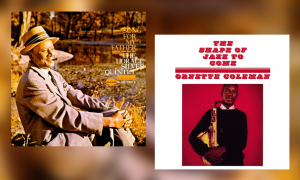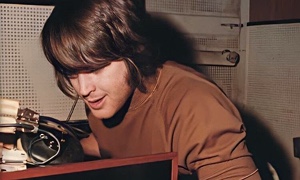Home » Jazz Articles » Building a Jazz Library » Free Improvisation
Free Improvisation
In Derek Bailey's words, improv is "playing without memory."
Although there are countless exceptions, free jazz developed in the USA whereas free improvisation blossomed in Europe. However, some of the most interesting and productive music arose from trans-Atlantic collaborations, witness the participation of Steve Lacy, Anthony Braxton and George Lewis in Company Weeks, Cecil Taylor's 1988 Berlin sojourn, or countless links between London and New York fostered by John Zorn.
The late 60s and early 70s were a defining period, when key musicians such as John Stevens, Derek Bailey, Tony Oxley, Evan Parker and Paul Rutherford took the music from infancy to maturity. In the process, they established modus operandi that have stood the test of time and continued to generate fine original music, even when employed by the next generation of improvisers.
The CD age has done a great service to free improvisation. Many key albums (including those below by Harriott, Giuffre, SME, Oxley) have seen the light of day for the first time in decades, helping to illuminate the history and roots of the music. Despite this, many fans of improv would insist that a recording can never be a substitute for the live experience; only live can one see the interactions between the musicians (and their interaction with the audience) that are so crucial in shaping the music. Nonetheless, all of these CDs are vital listening in their own right. While they barely scratch the surface of the music, they are essential starting points to understanding and enjoying improv.

Lennie Tristano: Intuition (1996)
Recorded in 1949, "Intuition" and "Digression" are the first recorded examples of free improvisation. Tristano instructed Warne Marsh, Lee Konitz & Co. to just play, with no pre-set chords or melody. The results are remarkable and historic. Believe in telepathy.

Joe Harriott: Free Form (1960)
Harriott is one of the neglected pioneers of free improvisation. His development of free playing was independent from that of Ornette Coleman but ran along a parallel path. This album is his masterpiece. Get it before it disappears for another four decades!

Ornette Coleman: Free Jazz (1960)
Although his music has never been free improvisation, Coleman's influence on the development of it was immense. All of his Atlantic recordings are essential. This one features a double quartet including Eric Dolphy, another key influence on the music.

Jimmy Giuffre: Free Fall (1962)
As early as 1954, ( The Three and The Two) Giuffre was experimenting with freedom. That culminated in this drummerless, chamber-jazz trio with Paul Bley and Steve Swallow. Ironically, following this sublime album, Giuffre spent years without a recording contract.

Spontaneous Music Ensemble: Karyobin (1968)
John Stevens and SME were central to the development of free improvisation, crucially transforming free jazz into free improvisation as we know it. This album features the dream team of Stevens, Derek Bailey, Evan Parker, Kenny Wheeler and Dave Holland. Wow.

Peter Brotzmann Octet: Machine Gun (1968)
A saxophonist of immense power and ferocious energy, Brotzmann produced this definitive statement early in his career. His octet here includes key European players such as Willem Breuker on tenor sax, Peter Kowald on bass and Han Bennink on drums, each an important leader in his own right.

Tony Oxley: The Baptised Traveller (1969)
This was one of the last free releases by a major label. (It is still free, even if they do play Charlie Mariano's "Stone Garden"!) The following year, Oxley, Derek Bailey and Evan Parker set up Incus Records, since when the music has largely been a cottage industry, with releases on independent labels.

Company: Once (1987)
The annual Company Week promoted the notion of players from disparate backgrounds being thrown together to improvise—often with remarkable results. This album is particularly notable for the presence of Lee Konitz, thirty-eight years on from the Tristano session.

Cecil Taylor: Leaf Palm Hand (1988)
From the late 50s onwards, Cecil Taylor was one of the founding fathers of free playing. His 1988 visit to Berlin brought together old and new world free improvisation in a rich and productive series of concerts and recordings. Many of them are essential, especially his five duo albums with different drummers. This one is with Oxley.

Charles Gayle: Touchin' on Trane (1991)
Bringing it all back home? Although released on the German label FMP, this trio with William Parker and Rashied Ali was proof that free improvisation was thriving in the USA. Gayle's playing is in the tradition of Albert Ayler or late Coltrane. Free jazz or improv? Who cares when it's this good!

Evan Parker: 50th Birthday (1994)
It is an impossible job selecting just one Evan Parker disc. This could as easily have been Duo (London) 1993 with Braxton, or 2X3=5 or many others. This double CD features both of Parker's long-term groups, his own trio with Barry Guy and Paul Lovens, and the Alex von Schlippenbach trio with Paul Lytton.

Evan Parker: Lines Burnt in Light (2001)
Parker at his brilliant best, alone in a church with a soprano sax, weaving magic. Circular breathing at its finest. Impossible to leave this one out. (The YouTube clip below was recorded the evening this album was recorded, and it gives a close-up view of Parker's technique.) Proof that the music is alive, well and thriving.
Tags
PREVIOUS / NEXT
Support All About Jazz
 All About Jazz has been a pillar of jazz since 1995, championing it as an art form and, more importantly, supporting the musicians who make it. Our enduring commitment has made "AAJ" one of the most culturally important websites of its kind, read by hundreds of thousands of fans, musicians and industry figures every month.
All About Jazz has been a pillar of jazz since 1995, championing it as an art form and, more importantly, supporting the musicians who make it. Our enduring commitment has made "AAJ" one of the most culturally important websites of its kind, read by hundreds of thousands of fans, musicians and industry figures every month.
























